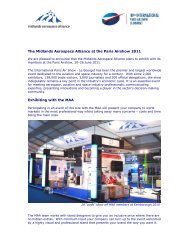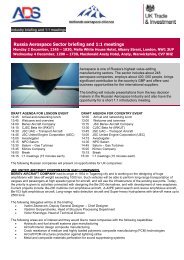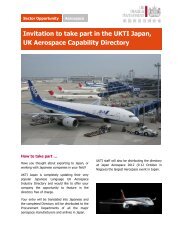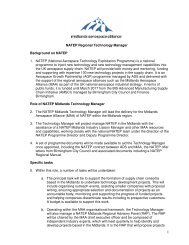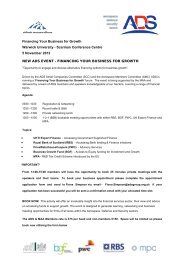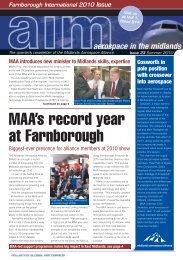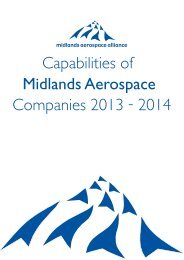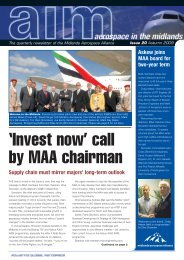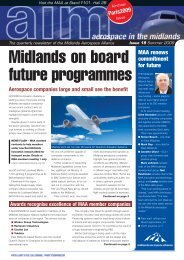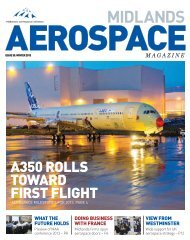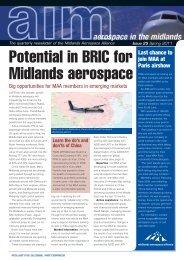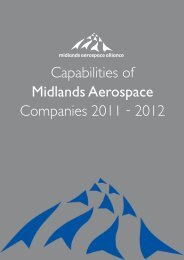Mobilising the Midlands aerospace cluster
Mobilising the Midlands aerospace cluster
Mobilising the Midlands aerospace cluster
- No tags were found...
Create successful ePaper yourself
Turn your PDF publications into a flip-book with our unique Google optimized e-Paper software.
6<br />
7<br />
ing <strong>the</strong> catalytic power of <strong>the</strong> <strong>cluster</strong>, government can exact maximum results<br />
from policy interventions.<br />
How can forward-thinking business and government leaders mobilise an existing<br />
<strong>aerospace</strong> <strong>cluster</strong> in North America, Europe or elsewhere? In bygone days <strong>cluster</strong>ing<br />
was more art than science. The art was practiced by experienced managers<br />
and skilled workers who, once inculcated in <strong>the</strong> ways of <strong>the</strong> industry at <strong>the</strong> big<br />
companies and education institutions, left to set up or work at local sub-contract<br />
suppliers. It was practiced in cosy relationships between seasoned buyers at<br />
large companies and <strong>the</strong>ir favoured local suppliers. And it was practiced in wage<br />
agreements forged by businessmen in <strong>the</strong> smoke-filled rooms of <strong>the</strong> region’s private<br />
clubs or in head-to-head battles with regional union chiefs who allied <strong>the</strong>mselves<br />
with local politicians.<br />
●<br />
The <strong>Midlands</strong><br />
<strong>aerospace</strong> <strong>cluster</strong><br />
Some recoil from anything that might smack of returning to such a past. Yet in<br />
an era where <strong>the</strong> global mindset threatens to dominate thinking, <strong>the</strong>re is a bigger<br />
risk, that of throwing out <strong>the</strong> regional baby with <strong>the</strong> local bathwater. The old black<br />
arts of running a regional economy are in any case irrelevant in today’s competitive<br />
environment. Astute <strong>aerospace</strong> business leaders look at <strong>cluster</strong>ing with fresh<br />
eyes, as a sophisticated and effective business tool. The more successfully <strong>the</strong>y<br />
exploit <strong>the</strong> resources of <strong>the</strong>ir <strong>cluster</strong>, <strong>the</strong> more <strong>the</strong>y can improve <strong>the</strong> performance<br />
of <strong>the</strong>ir companies — and <strong>the</strong>ir prospects in global <strong>aerospace</strong> markets. And <strong>the</strong><br />
more carefully atuned is public policy to <strong>the</strong> dynamics of <strong>the</strong> <strong>cluster</strong>, <strong>the</strong> more<br />
widely spread <strong>the</strong> benefits for <strong>the</strong> region as a whole.<br />
ANATOMY OF THE MIDLANDS<br />
AEROSPACE CLUSTER<br />
Porter defines <strong>cluster</strong>s as “geographic concentrations of interconnected companies<br />
and institutions in a particular field.” Interconnections can extend vertically<br />
— up and down supply chains — and laterally — spanning a range of<br />
sectors that use similar inputs or supply similar customers. In some <strong>cluster</strong>s<br />
government-funded agencies play significant linking roles by furnishing<br />
education and training or specialised transport infrastructures that resolve<br />
structural market failures. In some, regional industry bodies provide vital<br />
organisational glue. The precise anatomy of each <strong>cluster</strong> is different, and so are<br />
its dynamic forces.<br />
The world’s big <strong>aerospace</strong> <strong>cluster</strong>s are organised around large manufacturing<br />
plants where intricate precision assemblies — aircraft or <strong>the</strong>ir component systems<br />
— are designed and assembled from thousands of precision parts made<br />
internally or by supplier firms. Large labour pools support <strong>the</strong> factories, and <strong>the</strong><br />
large anchor companies employ local research institutions to help <strong>the</strong>m develop<br />
advanced technologies. Aerospace regions are not <strong>the</strong> type of <strong>cluster</strong> that is<br />
made up of groupings of collaborating small companies or commercial spinouts<br />
from university intellectual property.<br />
The dynamics of <strong>aerospace</strong> <strong>cluster</strong>s reflect <strong>the</strong> structure of <strong>the</strong> industry. With <strong>the</strong><br />
development and manufacture of technologically sophisticated aircraft as its raison<br />
d’etre, <strong>aerospace</strong> is fundamentally a collaborative venture. Cooperation is driven by<br />
technology intensity, safety considerations, and <strong>the</strong> long life of each aircraft programme<br />
– often 50 years or more in this low clockspeed industry. A competitor for<br />
position on a new aircraft programme may simultaneously be a collaborator on an<br />
existing one. Aerospace suppliers adhere to rigorous customer-approved production<br />
and quality inspection procedures to assure aircraft safety; a regulatory regime<br />
that inherently restricts market entry, especially for what <strong>the</strong> industry calls flying<br />
parts. With long timespans and tight regulation as powerful determinants of industry<br />
dynamics, companies and employees form natural professional communities<br />
over whole careers — and geographical <strong>cluster</strong>s amplify <strong>the</strong> sense of belonging.<br />
The structure of supply chains and <strong>the</strong>ir performance are fundamental to competitiveness<br />
in <strong>the</strong> industry. Virtually all companies succeed only by finding a niche in<br />
supply chain structures as complex as <strong>the</strong> aircraft itself. Performance improve-



